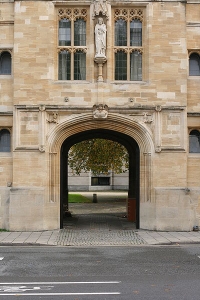Sunday, September 26. 2010
  An article by Ulrich Herb (2010) [UH] is predicated on one of the oldest misunderstandings about OA: that OA ≡ OA journals ("Gold OA") and that the obstacle to OA is that OA journals don't have a high enough impact factor: An article by Ulrich Herb (2010) [UH] is predicated on one of the oldest misunderstandings about OA: that OA ≡ OA journals ("Gold OA") and that the obstacle to OA is that OA journals don't have a high enough impact factor:UH:
"This contribution shows that most common methods to assess the impact of scientific publications often discriminate Open Access publications – and by that reduce the attractiveness of Open Access for scientists." The usual solution that is proposed for this non-problem is that we should therefore give OA journals a higher weight in performance evaluation, despite their lower impact factor, in order to encourage OA.
(This is nonsense, and it is not the "solution" proposed by UH. A journal's weight in performance evaluation needs to be earned -- on the basis of its content's quality and impact -- not accorded by fiat, in order to encourage OA.)
The "solution" proposed by UH is not to give OA journals a higher a-priori weight, but to create new impact measures that will accord them a higher weight. UH:
"Assuming that the motivation to use Open Access publishing services (e.g. a journal or a repository) would increase if these services would convey some sort of reputation or impact to the scientists, alternative models of impact are discussed." New impact measures are always welcome -- but they too must earn their weights based on their track-records for validity and predictivity.
And what is urgently needed by and for research and researchers is not more new impact measures but more OA.
And the way to provide more OA is to provide OA to more articles -- which can be done in two ways, not just the one way of publishing in OA journals (Gold OA), but by self-archiving articles published in all journals (whether OA or non-OA) in institutional repositories, to make them OA ("Green OA").
Ulrich Herb seems to have misunderstood this completely (equating OA with Gold OA only). The contradiction is evident in two successive paragraphs: UH:
"Commonly used citation-based indicators provide some arguments pro Open Access: Scientific documents that can be used free of charge are significantly more often downloaded and cited than Toll Access documents are (Harnad & Brody, 2004 ; Lawrence, 2001). Moreover the frequency of downloads seems to correlate with the citation counts of scientific documents (Brody, Harnad & Carr, 2006).
"Nevertheless there is lack of tools and indicators to measure the impact of Open Access publications. Especially documents that are self-archived on Open Access Repositories (and not published in an Open Access Journal) are excluded from the relevant databases (WoS, JCR, Scopus, etc.) that are typically used to calculate JIF-scores or the h-index" [emphasis added]. The bold-face passage in the second paragraph is completely erroneous, and in direct contradiction with what is stated in the immediately preceding paragraph. For the increased citations generated by making articles in any journal (OA or non-OA) OA by making them freely accessible online are included in the relevant databases used to calculate journal impact. Indeed, most of the evidence that OA increases citations comes from comparing the citation counts of articles (in the same journal and issue) that are and are not made OA by their authors. (And these within-journal comparisons are necessarily based on Green OA, not Gold OA.)
Yes, there are journals (OA and non-OA -- mostly non-OA!) that are not (yet) indexed by some of the databases (WoS, JCR, Scopus, etc.); but that is not an OA problem.
Yes, let's keep enhancing the visibility and harvestability of OA content; but that is not the OA problem: the problem is that most content is not yet OA.
And yes, let's keep developing rich, new OA metrics; but you can't develop OA metrics until the content is made OA.
References
Brody, T., Carr, L., Gingras, Y., Hajjem, C., Harnad, S. and Swan, A. (2007) Incentivizing the Open Access Research Web: Publication-Archiving, Data-Archiving and Scientometrics. CTWatch Quarterly 3(3).
Harnad, S. (2008) Validating Research Performance Metrics Against Peer Rankings. Ethics in Science and Environmental Politics 8 (11) doi:10.3354/esep00088 (Special issue: The Use And Misuse Of Bibliometric Indices In Evaluating Scholarly Performance)
Harnad, S. (2009) Open Access Scientometrics and the UK Research Assessment Exercise. Scientometrics 79 (1)
Herb, Ulrich (2010) OpenAccess Statistics: Alternative Impact Measures for Open Access documents? An examination how to generate interoperable usage information from distributed Open Access services., 2010 In: L'information scientifique et technique dans l'univers numérique. Mesures et usages. L'association des professionnels de l'information et de la documentation, ADBS, pp. 165-178
Monday, September 20. 2010
 Holly Mercer Holly Mercer reports that the self-archiving rate in library and information science is nearly 50% among librarians (and double the 20% global baseline even among nonlibrarians). Nevertheless, not even all articles for which immediate OA self-archiving has been endorsed by their publishers (c. 58-68%) are yet being self-archived even in library and information science, let alone the over 90% after embargo (or the 100% that can be deposited immediately in Closed Access allowing the semi-automatic eprint-request Button to provide Almost-OA during any embargo).
Among the potential solutions, the most important and effective one is for institutions and funders to mandate self-archiving. (Several library faculties have already taken the intiaitive of doing this.) It is also important to make institutional repository deposit the official mechanism for submitting publications for institutional and national performance review (see Liège model).
One slight correction: Alma Swan's reported rate of 49% self-archiving was not for total articles; it was just the percentage of authors who said they had self-archived at least once. (And both Alma's studies and those of others have found that authors are often not sure what they mean when they say they have self-archived!) This too will be self-corrected as self-archiving mandates, with their links to research assessment, grow.
Stevan Harnad
American Scientist Open Access Forum
Friday, September 17. 2010
Thursday, September 16. 2010
Note added 17 September: Many thanks to Hideki Uchijima, Librarian of the Kanazawa University Library, for providing a very comprehensive and conscientious response.
The response provides more accurate estimates of the percentage (11.1%) of Japanese annual refereed research article output that is currently being self-archived in the 158 Japanese Institutional Repositories that are being harvested by JAIRO, basing the estimate on the ISI Thompson-Reuters subset, an excellent first approximation (which we and others have also used to do such estimates), and confirming that Japan's unmandated self-archiving rate indeed falls within the global average baseline of 5-25%.
Hideki Uchijima also adds the good news that Hokkaido University (already registered in ROARMAP in 2008 as having an OA policy, but not yet an OA mandate) might soon be upgrading to a self-archiving mandate (and this might encourage further universities in Japan to do likewise).
And last, Hideki Uchijima will now also try to persuade the IR managers of the remaining 81 Japanese universities (out of the 158 JAIRO total) who (unlike Hokkaido University and 76 other Japanese universities) have not yet done so, to register their IRs in ROAR.
If all librarians, IR managers and OA activists worldwide were as attentive and responsive as Kanazawa University's librarian, the world would reach its goal of 100% OA far sooner. (Many are, but far, far more need to be!)
Note added 18 September: Andrew A Adams (Meiji University) wrote:
"During Open Access Week in October both Otaru University of Commerce and Hokkaido University will be holding meetings to promote deposit and adoption of a mandate. I have accepted invitations to speak at both events, arranged by Shigeki Sugita of the library at Otaru University of Commerce and Masako Suzuki of the library at Hokkaido University. Both are keen supporters of Green OA and a deposit mandate and are working hard to persuade managers and faculty at these two very different though physically close universities to adopt mandates (Otaru, being small and with limited funds has an access problem itself, whereas Hokkaido is one of the top ten universities in Japan..."
 Congratulations to Japan's JAIRO for harvesting the 700,000 full-texts (out of one million total) self-archived in Japan's 158 Institutional Repositories since 2007.
To understand what this figure means, however, the fundamental question is whether or not it represents an increase over the worldwide baseline average for spontaneous (i.e. unmandated) self-archiving, which varies between 5-25% of the total annual output of the primary target content of the Open Access movement: the 2.5 million articles per year published in the planet's 25,000 peer-reviewed journals across all disciplines and languages.
Of JAIRO's 700K full-text total, about 110K (15.5%) consisted of journal articles, based on JAIRO's statistical data.
From the growth chart (if I have interpreted it correctly), about 75% of 50,000 articles (i.e., 35,000 full-texts) were deposited in 2009. If we can assume that those deposits were all articles published within that same year (or the preceding one), then the question is: What percentage of Japan's (or of those 158 institutions') annual portion of the 2.5 million articles published yearly worldwide do these 35,000 full-texts represent? Does it exceed the worldwide unmandated baseline of 5-25%?
The reason I raise this question is because absolute figures -- even absolute growth rates across years -- are not meaningful in themselves. They are only meaningful if expressed as the percentage of total annual output. For a single institutional repository, this means the percentage of that institution's annual output of refereed journal articles. For Japan's 158 institutional repositories, it means the percentage of the total annual output of those 158 institutions.
On the conservative assumption that research-active universities publish at least 1000 refereed journal articles per year, the estimate would be that those 35K articles represent at most about 22% of those institutions' annual refereed journal article output, which falls within the global 5-25% unmandated baseline.
The reason I stress this point is that it is important that we do not content ourselves with absolute self-archiving totals and growth rates that look sizeable considered in isolation. The figure to beat is the unmandated baseline of 5-25%, and the only institutions that consistently beat it are those that mandate self-archiving. Their deposit rates jump to 60% and approach 100% within a few years.
There are already 170 self-archiving mandates worldwide registered in ROARMAP -- 96 institutional, 24 departmental and 46 funder mandates -- but alas none yet from Japan. If there are any, it would be very helpful if they would be registered in ROARMAP.
Also, although Japan has at least 158 repositories, only 77 of them are registered in ROAR:
It would be very helpful if the rest were registered in ROAR too...
References
Björk B-C, Welling P, Laakso M, Majlender P, Hedlund T, et al. (2010) Open Access to the Scientific Journal Literature: Situation 2009. PLOS ONE 5(6): e11273.
Gargouri, Y., Hajjem, C., Lariviere, V., Gingras, Y., Brody, T., Carr, L. and Harnad, S. (2010) Self-Selected or Mandated, Open Access Increases Citation Impact for Higher Quality Research. PLOS ONE (in press)
Harnad, S, (2008) Estimating Annual Growth in OA Repository Content. Open Access Archivangelism. August 9 2008
Sale, Arthur (2006) Researchers and institutional repositories, in Jacobs, Neil, Eds. O pen Access: Key Strategic, Technical and Economic Aspects, chapter 9, pages 87-100. Chandos Publishing (Oxford) Limited.
Sale, A. (2006) The Impact of Mandatory Policies on ETD Acquisition. D-Lib Magazine April 2006, 12(4).
Sale, A. (2006) Comparison of content policies for institutional repositories in Australia. First Monday, 11(4), April 2006.
Sale, A. (2006) The acquisition of open access research articles. First Monday, 11(9), October 2006.
Sale, A. (2007) T he Patchwork Mandate D-Lib Magazine 13 1/2 January/February
Stevan Harnad
American Scientist Open Access Forum
Wednesday, September 15. 2010
Thursday, September 2. 2010
 Frankel & Nestor's helpful advice to authors about rights retention is very well-informed and valuable, except for this: "Finally, we must be careful to distinguish between a license mandate and a deposit mandate. Whereas a licensewhether exclusive or nonexclusivetransfers some amount of rights in the article, a deposit mandate merely allows for (or requires) a physical copy of the article to be given to the institution. Simply handing over a physical copy of an article, or draft of that article, is not sufficient under copyright law to constitute a grant of any rights, as physical possession of an article does not give the owner of that copy any copyright rights in work embodied in the copy.
"Deposit mandates certainly are useful for institutions to retain the knowledge and scholarship of its faculty members. Indeed, some journals already permit institutional depositories. But such permissions do not address the increasing loss of knowledge in the academic community caused by the ever- increasing costs of journal subscriptions and the inability for academic institutions to keep up with shouldering the burden of those costs. The open access policy goes beyond a simple university depositorylimited in size, scope, and, most universal scope and accessibility. By combining the nonexclusive license discussed in this paper with a deposit policy, an institution can create open access."
Simon J. Frankel and Shannon M. Nestor (2010) Opening the Door: How Faculty Authors Can Implement an Open Access Policy at Their Institutions. (1) Most authors are not providing Open Access (OA) to their refereed research output at all today. (Only 20% are providing it.)
(2) OA Mandates are coming, but still extremely slowly.
(3) It is much harder to mandate more than less.
(4) A license mandate is much more than a deposit mandate.
(5) The majority of journals (60%+) already endorse immediate Open Access self-archiving of the author's refereed final draft.
(6) A deposit mandate will immediately provide OA to 60%+ instead of just 20% of refereed research.
(7) The repository's eprint-request button can provide almost-OA to all the rest for the time being.
(8) So what is urgently needed is at least a deposit mandate, today.
(9) Re-use rights are not urgent, and will be much easier to get once we already have universally mandated OA.
The Gratis Green OA self-archiving door is open already: All institutions and funders need do is mandate entry. Rights retention and Libre OA can come later.
Harnad, S. (2008) Waking OA’s “Slumbering Giant”: The University's Mandate To Mandate Open Access. New Review of Information Networking 14(1): 51 - 68
Harnad, S. (2008) Which Green OA Mandate Is Optimal? Open Access Archivangelism December 7 2008.
Harnad, S. (2010) The Immediate Practical Implication of the Houghton Report: Provide Green Open Access Now. Prometheus 28 (1). pp. 55-59.
Sale, A., Couture, M., Rodrigues, E., Carr, L. and Harnad, S. (2010) Open Access Mandates and the "Fair Dealing" Button. In: Dynamic Fair Dealing: Creating Canadian Culture Online (Rosemary J. Coombe & Darren Wershler, Eds.)
Suber, Peter (2008) Green/gold OA and gratis/libre OA. Open Access News August 2, 2008
|

 An article by
An article by 

 Eight more Green OA self-archiving mandates have been registered in
Eight more Green OA self-archiving mandates have been registered in 









